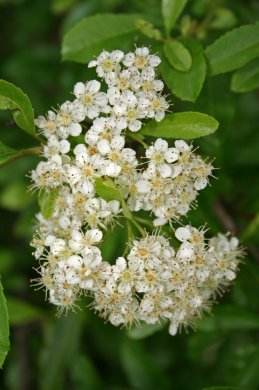The Pyracantha Rogersiana, also known as the Asian Firethorn is a remarkable plant. It’s called the Asian Firethorn because it originates from Western China.
The shrubs botanical name comes from the greek words ‘pyr’ meaning fire and ‘akantha’ meaning thorn; hence the name pyracantha!
It’s become popular around the world in many gardens due to its multiple uses and how much it stands out, no matter what time of year.
One of the famous varieties of this shrub is the Rogersiana ‘Flava’. It’s stand out feature is the bright yellow berries.
In this article, we’ll take a look at the Rogersianas unique characteristics and look at the multiple ways this shrub can be used to enrich your garden.
Rogersiana Characteristics
Blossoms
When spring comes, so do the white blossoms! Clusters of small white flowers appear all over the shrub. These add an array of colour which is not only great for you to look at, but also fantastic for attracting pollinators such as bees and butterflies.

Evergreen
The Rogersiana is evergreen with glossy, leathery leaves. The great thing about the leaves is they provide a lively green colour all year round.
If you’re garden lacks colour throughout the year then this is a good choice. It makes a nice back drop and will increase the visual appeal of most gardens, yards and dull walls.

Vibrant Berries
This is basically the party piece. Once the blossoms have fallen the berries appear, beginning as a pale yellow and gradually morphing into a fiery red come autumn. Adding a huge boost of colour to its surroundings.
Not only are they good to look at, the berries are a reliable food source to local wildlife in the winter. So you can sit back, admire the colour and watch as the shrub attracts all kinds of wildlife to feast on the berries.
Thorns Galore
As it’s part of the pyracantha family, it obviously comes with awn abundance of thorns! The thorns are on the branches to deter potential threats and because of this, make it a fantastic choice for hedging.
The thorns give added security within the hedge. You would think twice before crossing a boundary hedge that’s made from pyracantha let me tell you that.
Cultivating
This shrub is very low maintenance and will prosper in many environmental conditions. Cultivating the Rogersiana is a rewarding challenge; with that – let’s take a look how to cultivate it.
Location,location,location.
This shrub grows well in semi shade and direct sun. Make sure the soil is well drained, and that there is ample room for the shrub to grow naturally, allowing you to get the full benefit from the shrub all year round.
Pruning
It’s essential to prune your shrub to maintain its desired shape and size. However, due to the sheer amount of thorns, I recommend you wear some gardening gloves to avoid getting pricked! When dealing with pyracantha this is bound to happen at some point.
Periodic watering
When you first plant the rogersiana, water the soil 2-3 times a week ensuring you keep the soil moist during hot or dry spells; especially in the early stages.
Once the shrub has settled in, it will become more hardy and drought tolerant and will need less watering than early on.
The Benefits of Rogersiana
Low maintenance
Once it’s taken hold, this shrub requires barely any attention. It may need pruning twice a year if that! It’s perfect for people with busy schedules who don’t have much time, but have just enough time to sit in their garden once in a while and admire its beauty.
Natural bird feeder
As mentioned earlier, the birds absolutely love these berries so it can be quite entertaining to watch! They especially love them when everywhere is iced over and other food is inaccessible. Providing them with essential sustenance they otherwise might not get.
Overall, I think the Rogersiana is a good choice for people who want to liven up their outdoor space, no matter how big or small. If you’ve got a small yard, you can train it along the wall. Or if you have a big garden you can simply put it in the border, either way you won’t regret it!
It’s a hardy shrub with minimal diseases that can survive extreme temperatures AND provide colour and food. What’s not to love?

